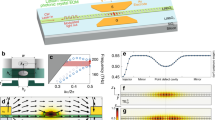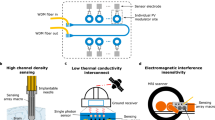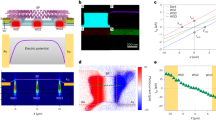Abstract
The introduction of photonic technologies into mature electronic circuits is in high demand to accelerate on-chip information networking and even computing. Great difficulty lies in the fact that the optoelectronic coupling at their interfaces requires a substantial charging energy determined by their capacitance. Optoelectronic devices have been too large to reduce the integrated capacitance down to the femtofarad scale. Here we use a photonic-crystal platform to demonstrate the first experimental proof of optoelectronic integration at only 2 fF. This allows us to realize a record-low attojoule-energy electro-optic modulator (an electrical-to-optical or E–O converter) and an amplifier-free photoreceiver (an optical-to-electrical, or O–E converter), which leads to ultralow-energy signal conversion. By integrating these O–E/E–O devices, we demonstrate femtofarad ‘O–E–O transistors’ with optical signal gain that show various optical nonlinear functions, including as all-optical switches, wavelength converters and cascadable optical repeaters with a femtojoule-per-bit energy consumption. These femtofarad-scale O–E/E–O/O–E–O devices promise tightly coupled photonic–electronic integration for new fields of energy-saving information processing.
This is a preview of subscription content, access via your institution
Access options
Access Nature and 54 other Nature Portfolio journals
Get Nature+, our best-value online-access subscription
$29.99 / 30 days
cancel any time
Subscribe to this journal
Receive 12 print issues and online access
$209.00 per year
only $17.42 per issue
Buy this article
- Purchase on Springer Link
- Instant access to full article PDF
Prices may be subject to local taxes which are calculated during checkout





Similar content being viewed by others
Data availability
The data that support the plots within this paper and other findings of this study are available from the corresponding author on reasonable request.
References
Williams, R. S. What’s next? Comput. Sci. Eng. 19, 7–13 (2017).
Miller, D. A. B. Device requirements for optical interconnects to silicon chips. Proc. IEEE 97, 1166–1185 (2009).
Miller, D. A. B. Attojoule optoelectronics for low-energy information processing and communications. J. Lightwave Technol. 35, 346–396 (2017).
Sorger, V. J. et al. Scaling vectors of attojoule per bit modulators. J. Opt. 20, 014012 (2018).
Krishnamoorthy, A. V. & Miller, D. A. B. Scaling optoelectronic-VLSI circuits into the 21st century: a technology roadmap. IEEE J. Sel. Top. Quant. Electron. 2, 55–76 (1996).
Timurdogan, E. et al. An ultralow power athermal silicon modulator. Nat. Commun. 5, 4008 (2014).
Settaluri, K. T. et al. Demonstration of an optical chip-to-chip link in a 3D integrated electronic-photonic platform. In 41st European Solid-State Circuits Conference (ESSCIRC) 156–159 (IEEE, 2015).
Nozaki, K. et al. Photonic-crystal nano-photodetector with ultrasmall capacitance for on-chip light-to-voltage conversion without an amplifier. Optica 3, 483–492 (2016).
Lentine, A. L. et al. Symmetric self-electrooptic effect device: optical set-reset latch, differential logic gate, and differential modulator detector. IEEE J. Quant. Electron. 25, 1928–1936 (1989).
Kasahara, K. Vstep-based smart pixels. IEEE J. Quant. Electron. 29, 757–768 (1993).
Matsuo, S., Amano, C. & Kurokawa, T. Photonic memory switch consisting of multiple quantum-well reflection modulator and heterojunction phototransistor. Appl. Phys. Lett. 60, 1547–1549 (1992).
Mccormick, F. B. et al. Six-stage digital free-space optical switching network using symmetrical self-electro-optic-effect devices. Appl. Opt. 32, 5153–5171 (1993).
Demir, H. V. et al. Multifunctional integrated photonic switches. IEEE J. Sel. Top. Quant. Electron. 11, 86–96 (2005).
Matsuo, S., Amano, C. & Kurokawa, T. Operation characteristics of 3-terminal hybrid structure with multiple-quantum-well reflection modulator and heterojunction phototransistor. IEEE Photon. Technol. Lett. 3, 330–332 (1991).
Kodama, S. et al. 2.3 picoseconds optical gate monolithically integrating photodiode and electroabsorption modulator. Electron. Lett. 37, 1185–1186 (2001).
Nozaki, K. et al. Ultracompact O-E-O converter based on a fF-capacitance nanophotonic integration. In Conference on Laser and Electro-Optics (CLEO) SF3A.3 (Optical Society of America, 2018).
Li, E. W., Gao, O., Chen, R. T. & Wang, A. X. Ultracompact silicon-conductive oxide nanocavity modulator with 0.02 lambda-cubic active volume. Nano Lett. 18, 1075–1081 (2018).
Haffner, C. et al. Low-loss plasmon-assisted electro-optic modulator. Nature 556, 483–486 (2018).
Nozaki, K. et al. Ultralow-energy electro-absorption modulator consisting of InGaAsP-embedded photonic-crystal waveguide. APL Photon. 2, 056105 (2017).
Miller, D. A. B. Energy consumption in optical modulators for interconnects. Opt. Express 20, A293–A308 (2012).
Koeber, S. et al. Femtojoule electro-optic modulation using a silicon-organic hybrid device. Light Sci. Appl. 4, e255 (2015).
Yoshimatsu, T., Kodama, S., Yoshino, K. & Ito, H. 100-Gb/s error-free wavelength conversion with a monolithic optical gate integrating a photodiode and electroabsorption modulator. IEEE Photon. Technol. Lett. 17, 2367–2369 (2005).
Sabnis, V. A. et al. Intimate monolithic integration of chip-scale photonic circuits. IEEE J. Sel. Top. Quant. Electron. 11, 1255–1265 (2005).
Nozaki, K., Matsuo, S., Shinya, A. & Notomi, M. Amplifier-free bias-free receiver based on low-capacitance nanophotodetector. IEEE J. Sel. Top. Quant. Electron. 24, 4900111 (2018).
Durhuus, T., Mikkelsen, B., Joergensen, C., Danielsen, S. L. & Stubkjaer, K. E. All-optical wavelength conversion by semiconductor optical amplifiers. J. Lightwave Technol. 14, 942–954 (1996).
Yamada, K. et al. All-optical efficient wavelength conversion using silicon photonic wire waveguide. IEEE Photon. Technol. Lett. 18, 1046–1048 (2006).
Shinya, A. et al. All-optical on-chip bit memory based on ultra high Q InGaAsP photonic crystal. Opt. Express 16, 19382–19387 (2008).
Gu, T. et al. Regenerative oscillation and four-wave mixing in graphene optoelectronics. Nat. Photon. 6, 554–559 (2012).
Nozaki, K. et al. Sub-femtojoule all-optical switching using a photonic-crystal nanocavity. Nat. Photon. 4, 477–483 (2010).
Woodward, T. K. et al. 1-Gb/s two-beam transimpedance smart-pixel optical receivers made from hybrid GaAs MQW modulators bonded to 0.8-mu m silicon CMOS. IEEE Photon. Technol. Lett. 8, 422–424 (1996).
Dummer, M. M., Klamkin, J., Tauke-Pedretti, A. & Coldren, L. A. 40 Gb/s field-modulated wavelength converters for all-optical packet switching. IEEE J. Sel. Top. Quant. Electron. 15, 494–503 (2009).
Miller, D. A. B. Are optical transistors the logical next step? Nat. Photon. 4, 3–5 (2010).
Nozaki, K. et al. Forward-biased nanophotonic detector for ultralow-energy dissipation receiver. APL Photon. 3, 046101 (2018).
Werner, S., Navaridas, J. & Lujan, M. A survey on optical network-on-chip architectures. ACM Comput. Surv. 50, 89 (2018).
Touch, J. et al. Digital optical processing of optical communications: towards an optical turing machine. Nanophotonics 6, 507–530 (2017).
Ishihara, T., Shinya, A., Inoue, K., Nozaki, K. & Notomi, M. An integrated nanophotonic parallel adder. ACM. J. Emerg. Technol. Comput. Syst. 14, 1–20 (2018).
Tait, A. N. et al. Neuromorphic photonic networks using silicon photonic weight banks. Sci. Rep. 7, 7430 (2017).
Shen, Y. C. et al. Deep learning with coherent nanophotonic circuits. Nat. Photon. 11, 441–446 (2017).
Ren, S. et al. Ge/SiGe quantum well waveguide modulator monolithically integrated with SOI waveguides. IEEE Photon. Technol. Lett. 24, 461–463 (2012).
Haffner, C. et al. All-plasmonic Mach-Zehnder modulator enabling optical high-speed communication at the microscale. Nat. Photon. 9, 525–518 (2015).
Sorger, V. J., Lanzillotti-Kimura, N. D., Ma, R. M. & Zhang, X. Ultra-compact silicon nanophotonic modulator with broadband response. Nanophotonics 1, 17–22 (2012).
Srinivasan, S. A. et al. 56 Gb/s germanium waveguide electro-absorption modulator. J. Lightwave Technol. 34, 419–424 (2016).
Acknowledgements
We thank J. Asaoka, H. Onji, Y. Shouji and K. Ishibashi for their support in fabricating the device. This work was supported by CREST (JPMJCR15N4), the Japan Science and Technology Agency.
Author information
Authors and Affiliations
Contributions
K.N. designed the devices and performed the measurements. S.M., T.F. and K.T. supported the design and fabrication of the samples. A.S. and E.K. supported the design and fabrication of the photonic-crystal structure. M.N. led the project. K.N. and M.N. conceived and planned this work, analysed the data and wrote the manuscript.
Corresponding authors
Ethics declarations
Competing interests
The authors declare no competing interests.
Additional information
Publisher’s note: Springer Nature remains neutral with regard to jurisdictional claims in published maps and institutional affiliations.
Supplementary information
Supplementary Information
Supplementary Results and Discussion, Supplementary Figs. 1–12 and Supplementary Refs. 1–43.
Rights and permissions
About this article
Cite this article
Nozaki, K., Matsuo, S., Fujii, T. et al. Femtofarad optoelectronic integration demonstrating energy-saving signal conversion and nonlinear functions. Nat. Photonics 13, 454–459 (2019). https://doi.org/10.1038/s41566-019-0397-3
Received:
Accepted:
Published:
Issue Date:
DOI: https://doi.org/10.1038/s41566-019-0397-3
This article is cited by
-
Fiber optic computing using distributed feedback
Communications Physics (2024)
-
Photonic matrix multiplication lights up photonic accelerator and beyond
Light: Science & Applications (2022)
-
Guiding principle of reservoir computing based on “small-world” network
Scientific Reports (2022)
-
A silicon photonic–electronic neural network for fibre nonlinearity compensation
Nature Electronics (2021)
-
Energy harvesting optical modulators with sub-attojoule per bit electrical energy consumption
Nature Communications (2021)



